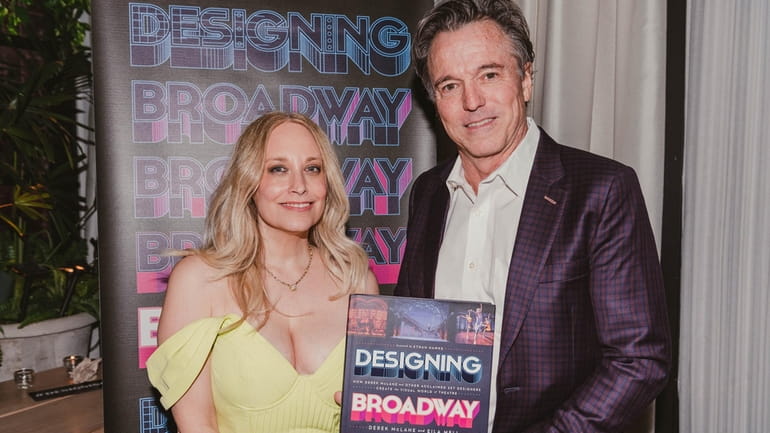The spotlight is on sets in 'Designing Broadway'

Elia Mell of Long Island and Derek McLane celebrate at the book launch for “Designing Broadway.” Credit: Michaelah Reynolds
A Broadway set is at once often the most looked at and overlooked aspect of a production. Photographs typically show actors with the set as a blur in the background.
Broadway sets, however, take center stage in Long Island resident Eila Mell’s and set designer Derek McLane’s eye-popping and eye-opening “Designing Broadway” (Running Press, $45). Mell, whose love of theater was nurtured during summers at Usdan Summer Camp for the Arts in Wheatley Heights, partnered with McLane, who designed the sets for Broadway's "Moulin Rouge!," "MJ" and "Almost Famous" as well as those for the live productions of "The Sound of Music," "Peter Pan" and "The Wiz" at Grumman Studios in Bethpage. The result is an appreciation and analysis of an aspect of theater that doesn’t typically garner applause, although it sometimes leads to awards.
Mell and McLane (who won two Tonys and two Emmys) talked with Newsday about the role of set design and designers on Broadway.
Why a book on set design?
Mell: I’m not a designer, but a fan of design. Going to a show, that’s the first thing you see when you walk into the theater. I found that very interesting to explore.
How did this collaboration evolve?
McLane: Eila called me. I think she had just seen "Moulin Rouge!" She suggested maybe we should do a book on my design work. At first, I was surprised and thrilled. Sure enough, other people were interested.
What is the reason for including other designers?
McLane: I don’t feel worthy yet of having my own book to myself. There are so many other great designers working. During the pandemic, I became aware of my community of fellow designers. We had weekly conversations throughout the pandemic. We all work in a community that influences each other. I wanted to capture some of that experience.
How did Usdan influence or encourage your love of theater?
Mell: As a student at Usdan, I discovered there were other kids who loved theater like I did. What a revelation to find my people, many of whom I am still friends with.
You’ve written and co-written other theater books. How did you get involved in writing about theater?
Mell: It’s something that has been part of my life always, since I was 12 years old. It seemed like a natural. I started writing about theater, film and televisions. It’s not a far leap to do this book.
How and why did you get involved in theater and design?
McLane: I got involved specifically in design rather than theater. I had done some house construction as a summer job prior to starting college. In college, somebody asked me to build a set. So I did. That exposed me to set design. I thought this is such a cool thing. I want to do this.
What did you find most interesting or surprising about design?
Mell: I never thought about the science part of the job, figuring out how the set moves, where pieces are stored when they’re not on stage. That as an audience member didn’t occur to me.
What’s the process of putting a book like this together with so many voices and images?
Mell: Derek and I sat down and decided what we wanted each section to be. We figured out what story we wanted to tell, even though it’s not a linear story. It’s one general story of design. “Burst of Color” is one section. We have "Hairspray" and "How to Succeed in Business Without Really Trying." Another is “Biomusicals” with "Beautiful," "MJ," "Jersey Boys." Once we figured that out, we plugged in the shows we wanted to discuss and who we wanted to reach out to.
What’s the question you try to answer with a set?
McLane: What is the world? How do you define the world? That’s the thing I spend endless amounts of time wrestling with in every show.
Who is the audience for the book?
Mell: We wrote this book with the intention that it’s for anyone interested in theater, not just set design. We tell stories of the plays in a lot of cases and not specifically the design, although that’s in the background.
How closely do you look at a set when you go to a show?
McLane: I always look at the set, whether it’s my show or someone else’s. And I analyze it. I love when I can just lose myself in a story. I try to let myself do that whenever I go to theater.
Do you have a signature?
McLane: I’m sure I do. I’ve been told by colleagues they’ve gone into a theater, sat down and without opening the program realized it was one of my sets. I try to avoid my own style and let that come out of whatever the show is.
Which of your sets are you most proud of?
McLane: Sometimes, I’ll be most proud of one thing. Then I work on something else and that replaces it in my mind. "Moulin Rouge!" will probably always stand out as something I’m particularly proud of, partly because of the scale of it. I had such a great time working on it. I loved the collaborators on it and the world that all of us created, the designers, and director.
